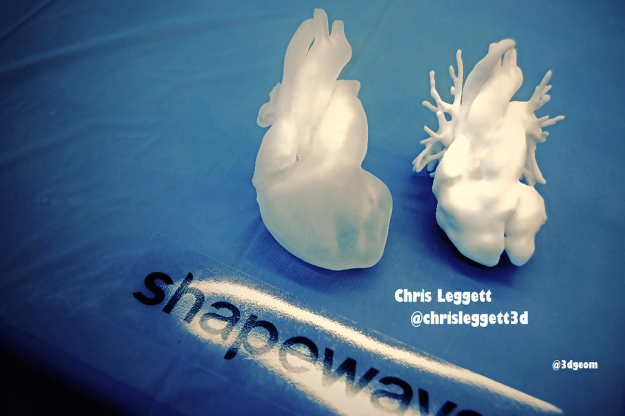
Last month I traveled to Maryland for the 2015 Bioinformatics & Computational Biosciences Festival, Science-In-3D. The industry-wide festival featured presentations about the emerging role of 3D technology by noted experts in academia, government and the industry. The event included speakers and, as a Shapeways Crew member, I was representing Shapeways in the exhibitor space and gave a talk during the final lightning round of presentations.

3D printed cell and DNA models at Science in 3D
I’ve used Shapeways to sell fashionable hats, goods, pen holders and color proteins through my Shapeways shop, but I have also used it to 3D print models which have enabled me to build incredible models for the science community, including the NIH 3D Print Exchange, and as proof-of-concept to secure business contracts for processing medical scan data for private commercial websites and corporations.

Melanie Robinson of Molecular Jig Games and Michael Astra from XVIVO admiring 3D printed molecules at Science in 3D
While I enjoy freelancing as a designer and working on various collaborations, I love demonstrating how everyone can print anatomical models with very little investment using open source software packages and Shapeways.
For example, I created these hearts just for the NIH Science in 3D festival:

3D printed hearts in Frosted Ultra Detail and White Strong Flexible plastic
I found the models on the NIH 3D Print Exchange, and 3D printed them with Shapeways in Frosted Ultra Detail (left) and white strong and flexible nylon plastic (right).
To learn more about how to use data like that available from the NIH 3D Print Exchange to create printable models, I created this tutorial specifically geared towards modelers interested in printing anatomical models.
How to Close Holes and Clean Large 3D Models – Part 1 from Christopher Leggett on Vimeo.
The exhibition featured many different models available from Shapeways, created by designers who are scientists and others who have a keen interest in science. You can see more in this display video I created with Jeremy Swan, a contractor with the NIH. The models you can see in the video below include: White and red blood cells by Somersault 18:24, DNA Molecule and Antibody model by FabMOL, Tardigrade by Raw Legend Collaborations, Gyro the Cube by Virtox, and a tree moth and Morton the Elephant by HiLobster.
I also presented Chris’s Histone Protein model renders, which are also available on the NIH 3D exchange.

The Shapeways table at Science in 3D
As the science and medical world continues to explore many different applications for 3D printing, I’m interested to hear from other scientists and science fans on Shapeways – how are you using 3D printing? How would you like to?



Really cool models ! I love that shapeways drives inovation forward. On a related note: Where can I get the little red antibody to the right seen in the first picture ? Seems not to be linked.
Cheers guys, keep up the good work !
Hi, Patrick! Thanks so much for your comment! You can find the antibody here:
So, will there be a “Science” category in the shop section some day, or do we keep categorizing our work as “Mathematical Art” or unspecified “Miniatures” ?
(Been creating lecture models of key compound structures in inorganic solid-state chemistry for some time now, though none are for sale and the recent repricing of WSF did hurt somewhat)
I completely agree with mkroeker. We science-minded shapeways designers need a showcase for our work that is separate from Mathematical Art or Miniatures. Or, better yet, put Mathematical Art under the more general rubrik of “Science,” which could then include the categories “biology”, “chemistry”, “math” etc. It would make it easier for people to find us.
Thank you for all your feedback on this! I’ve been thinking about how to bring together the scientific community/science models on Shapeways. I made a short survey if you would like to contribute your responses – it will really help me think about how we can better surface and promote our scientific model modelers on Shapeways! Thanks!
Great idea!